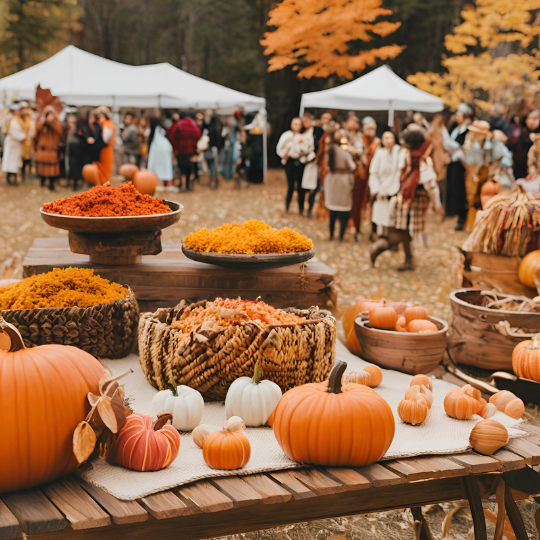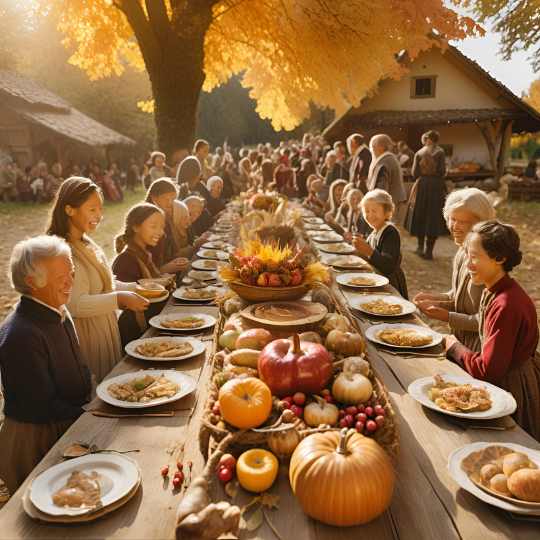The Fall Festival is known by a couple of different terms it’s origin and purpose is basically the same. The Fall Festival is also commonly known as the Harvest Festival or Mid-Autumn Festival. The Wikipedia definition of Fall Festival states that – “Fall Festival may refer to any festival during the fall season”, such as:
In China the Mid-Autumn Festival has a long history of more than 3,000 years. It came about from the custom of Chinese emperors worshipping the moon during the Zhou Dynasty. The Song dynasty was the first to have a Mid-autumn Festival. Nowadays, it is a Chinese public holiday and has been China’s second-most-important festival.
Chinese History of Fall Festival
1. Originated in the Zhou Dynasty (1045 – 221 BC)
Ancient Chinese emperors believed that worshipping the harvest moon in autumn would bring them a plentiful harvest the next year.
The custom originated from offering sacrifices to the moon goddess. It was recorded that kings offered sacrifices to the moon in fall during the Western Zhou Dynasty (1045 – 770 BC). The term “Mid-Autumn” first appeared in the book Rites of Zhou which was written in the Warring States Period (475 – 221 BC). However, at that time the term was only related to the time and season. The festival didn’t exist at this point in history.
2. Became Popular in the Tang Dynasty (618 – 907 AD)
Appreciating the moon became popular among the upper class.
Following the emperors, rich merchants and officials held big parties in their courts. They drank and appreciated the bright moon. Music and dances were also indispensable. Meanwhile, the common people prayed to the moon for a good harvest.
Later in the Tang Dynasty, all citizens began to appreciate the moon together, not just the rich merchants and officials.
3. Became a Festival in the Song Dynasty (960 – 1279 AD)
The 15th day of the 8th lunar month was established as the “Mid-Autumn Festival” in the Northern Song Dynasty. From this time on sacrificing to the moon was very popular and has become a custom ever since.
4. Mooncakes Eaten from the Yuan Dynasty (1279 – 1368 AD)
Eating mooncakes during the festival became a tradition in the Yuan Dynasty. The Mongols ruled during the Yuan Dynasty. The mooncakes were used to pass messages to rebels against the Mongols.
5. Popularity Peaked in the Ming and Quin Dynasties (1368 – 1912 AD)
The Mid-Autumn Festival was just as popular as the Chinese New Year during the Ming Dynasty (1368 – 1644 AD) and the Qing Dynasty (1644 – 1912 AD).
Many different activities were promoted to celebrate the Mid-Autumn Festival. Such as burning pagodas and performing the fire dragon dance.
6. Became a Public Holiday from 2008
Many traditional activities are disappearing from Mid-Autumn festivities. However, new trends are being made.
Most workers and students see it as a public holiday to get off work or out of school. People go traveling with families or friends, or they watch the Mid-Autumn Festival Gala on TV at night.
Share this 3-minute video with your family about the Mid-Autumn Festival story.
The most popular Mid-Autumn Festival foods include mooncakes – the must eats, pumpkin – brings good health, river snails – assure a good harvest, taro – bring good luck, lotus root – symbolizes strong family bonds, osmanthus wine – for happy life, pomegranate – symbol for fertility, and hairy crabs – a seasonal festival delicacy. This is only a few of the festival foods and their symbolism but there are many more.
Harvest Festivals (Fall Festivals)
So, Fall Festivals, Harvest Festivals, Mid-Autumn Festivals, while known by many names it is celebrated all over the World! Every culture has their version of the Harvest Festival but the reason is the same. To celebrate the success of the current harvest and to ask for blessings for an abundant harvest in the year to come.
In the British Isles, the time of the harvest has been celebrated since Pagan times before the English monarchy converted to Christianity around the 7th Century. They often take place in the local church and have become integrated with Church of England traditions.
Many ancient Pagan celebrations have been adopted by the Christian church or as non-religious events, including Christmas and Halloween, adapted from Winter Solstice and Celtic New Year traditions. These seasonal events originate in nature and the seasons. They have also persisted in British folklore and heritage despite changing dominant religions.
A successful harvest was essential for the community to weather the winter especially before international imports became common This is why there have been Harvest Festivals for thousands of years in Britain. Here are a couple well-known British Harvest poems for inspiration.
Thanksgiving by Anonymous "The year has turned its circle, The seasons come and go. The harvest all is gathered in And chilly north winds blow. Orchards have shared their treasures, The fields, their yellow grain, So open wide the doorway - Thanksgiving comes again!" A Harvest Prayer by Brenda Williams "Thank you for the harvest When fruit and berries grow. Thank you for the ripening corn Planted long ago. Thank you for the autumn And a warm and sunny day. Thank you for the harvest And crops to store away. Thank you for the sugar beet And fields of new-mown hay To feed the cows and horses When winter comes to stay."
- Harvest Time by John Jay Chapman
- The harvest Moon by Henry Wadsworth Longfellow
- Harvest by Ellen Mackay Hutchinson Cortissoz
- The Corn Song by John Greenleaf Whittier
- A Carol of Harvest for 1867 by Walt Whitman
Harvest Day or Harvest Festival
Usually coincides with the Harvest moon – the closest full moon to the autumn equinox.
Before it was known as harvest Day, it was Lammas Day, which was a pagan dedication of the first fruits of the farmer’s harvest. Early English church adopted Lammas, also known as Gule of August, as a Christian holiday and claimed it to mark the beginning of the harvest season on August 1. “Lammas” comes from the Old English “half (loaf)” and “maesse (mass), thus giving us “loaf-mass.” Farmers would make loaves of bread from the crops of fresh wheat and give them to local churches as a way to thank God for the harvest. This became a tradition until King Henry VIII broke away from the Catholic Church. Then a new traditions were formed. These included feasting, contests, games, music, poems, and feelings of merriment and pushed to the end of the harvest season.
Modern celebrations are often held on autumn after the crops have been collected. For Christian’s often a way of showing gratitude for the bounty the God has provided for us, particularly the nutrients for us to eat. It is now celebrated as a special time to get together in the fall and enjoy seasonal food and treats. Marked with games, crafts and activities, churches use it as a time for the community to come together and share the abundance of the year with everyone. Some use it as an alternative to Halloween, but either way it is the announcement that Fall has arrived!
History of Harvest Festival in the USA
One of the most important festivals in the USA is Thanksgiving. This was a celebration by the English settlers marking the first harvest in America nearly 400 years ago.
The first puritan settlers were known as the Pilgrim Fathers.
Today churches use it as a celebration and way to collect gifts and provisions to share with those less fortunate along with sharing a special meal. They eat turkey, sweet potato, sweet corn, cranberry sauce, followed by sweet pumpkin pie for dessert. I wonder if they enjoyed a true fine wine during their Harvest Festival gatherings?
This special harvest festival is celebrated on the fourth Thursday in November.
The first thanksgiving was in 1620 a group of Dutch and English families sailed on the Mayflower from a place known as Plymouth. They wanted to be free to worship their own god and not the faith of the Church of England. This pilgrimage is the reason why these settlers were known as the Pilgrim Fathers.
They set sail for the east-coast of America but ran into trouble causing their landing on the Massachusetts coast.
They were forced to build shelters for their landing was in the middle of winter. The Indians living in this part of the country tried to help them. Even with shelter and help from the Indians many of them died from diseases and the cold. In spite of this all, they fought on.
When spring came they sowed their crops which were believed to be wheat, rye, oats, beans, carrots and onions. The Indians also had their own crops which the Pilgrim Fathers had never seen the likes of before. The settlers called these crops maize, Indian corn, and potatoes. They also had good fishing as well as other meat such as deer and bison. There were also birds known as a turkey.
This first harvest provided supplies for the next winter and most of all plenty of seed for sowing the next years crops. Because of their religion they set aside a day to thank God for their good harvest. After they thanked God they cooked a special meal. They invited the Indians who had helped them to join in their feast.
Today we eat turkey with vegetables and cranberry sauce, followed by pumpkin pie. One recipe they might have had was Sweet Candied Potatoes also a dish called Succotash.
So… why do we celebrate Harvest Festival?
The Bible mentions Harvest a lot! Lets consider Harvest past, present and future.
Harvest Past – When did Harvest Begin?
Do you know when the first Harvest Festival took place?
“In the course of time Cain brought some of the fruits of the soil as an offering to the LORD. But Abel brought fat portions from some of the firstborn of his flock.” (Genesis 4:3-4)
From the very beginning and right through history, people have given back to God some of what he has given them. Harvest Festival began as a way of saying “thank you”.
So, while there are many cultures all over the World that celebrate the harvest it stands to be obviously known there are an abundance of foods to use to celebrate with. But let us not forget to celebrate with the fine wines that are also created from the harvest by generations of wine crafters. You can have these beautiful wines delivered to your door and have them to add to your celebration.
Come Join us today! Get added to our FREE online e-mail list to stay in the know when we add New Treasures and Gems to this site!
And believe me, we are searching, testing, and adding All the time and you don’t want to miss out!



